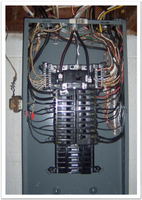
Many times when working with home buyers we are asked, “This home has aluminum wiring, should I be worried?” The answer is, not necessarily.
Many home buyers while looking for a home are scared off from considering a nice home because the home has aluminum wiring. Aluminum wiring doesn’t necessarily mean a home is unsafe, an older home with aluminum wiring might just need some minor updates to the home wiring.
Aluminum wire has been used in houses, power grids, and airplanes. Actually, aluminum provides a better conductivity to weight ratio than copper, and that is why it is used in power wiring of some aircraft. Most people didn’t know that utility companies have used aluminum wire for electrical transmission in power grids since the early 1900s. Because it has cost and weight advantages over copper wires, aluminum wire is the preferred material in transmission and distribution applications.
When the price of copper spiked in the mid-1960s, aluminum wire was manufactured in sizes small enough to use in homes to save on building cost. Aluminum wire requires a larger wire gauge than copper to carry the same current.
When aluminum wiring was first used in homes , it was installed the same way as copper. Typical connections from electrical wire to electrical devices, are usually made by wrapping the wire around screw terminals and tightening the screw. Over time, many of these terminations to aluminum wire began to fail due to improper connection techniques and dissimilar metals having different resistances. These connection failures generated heat under electrical load and caused overheated connections.
In the late 1960s, a device specification were revised several time for aluminum wiring. A new specification called CO/ALR (meaning copper-aluminum, revised) was created. CO/ALR applies only to standard light switches and receptacles; CU/AL is the standard marking for circuit breakers and larger equipment.
Upgrading or Repairing Aluminum Wiring in Homes
There are several upgrade or repair options that can be used in pre-1974 homes with aluminum wiring.
- The most expensive option is completely rewiring the house with copper wires.
- "Pigtailing" is a less expensive option that involves splicing a short length of copper wire (pigtail) to the original aluminum wire, and then attaching the copper wire to the existing electrical device. The splice of the copper pigtail to the existing aluminum wire uses special wire nuts, special crimp connectors, or special miniature lug-type connectors.
Aluminum wiring in a home shouldn’t scare a home buyer off from purchasing a home. Many times a home owner who is selling the home has already performed the recommended safety upgrades to the home wiring. Check out this article for more information on aluminum wiring.

